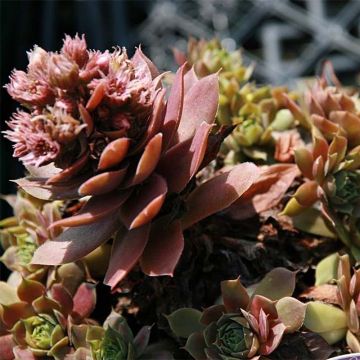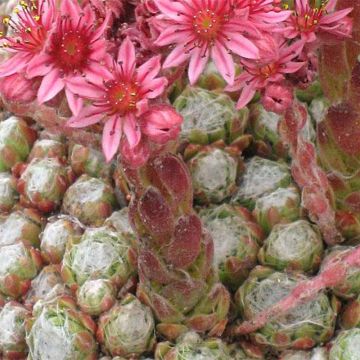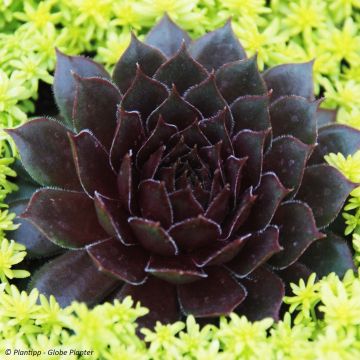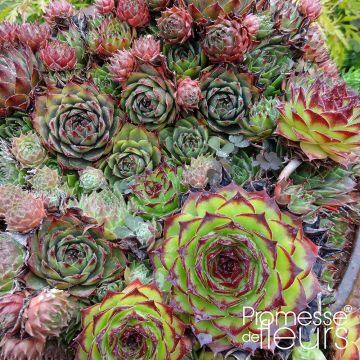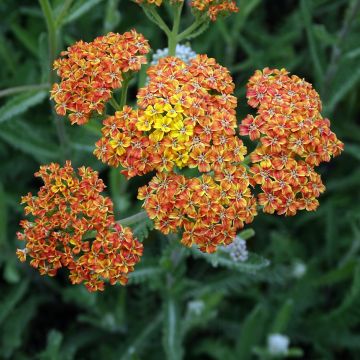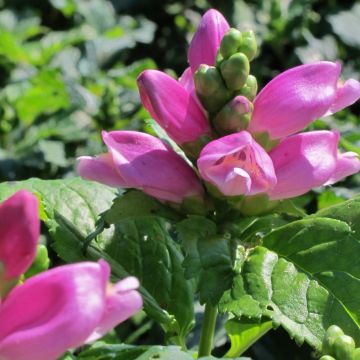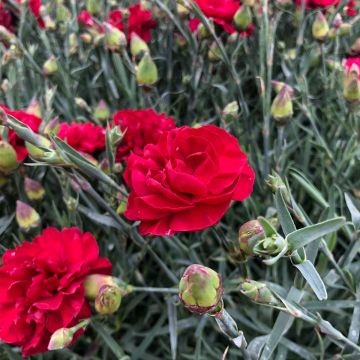

Sempervivum Butterscotch Baby
Sempervivum Butterscotch Baby
Sempervivum x hybrida 'Hordubal' BUTTERSCOTCH BABY ( CHICK CHARMS® series )
Houseleek, Hen and Chicks
Why not try an alternative variety in stock?
View all →This plant carries a 12 months recovery warranty
More information
We guarantee the quality of our plants for a full growing cycle, and will replace at our expense any plant that fails to recover under normal climatic and planting conditions.
From €5.90 for pickup delivery and €6.90 for home delivery
Express home delivery from €8.90.
Does this plant fit my garden?
Set up your Plantfit profile →
Description
Sempervivum 'Butterscotch Baby' (Chick Charms series) is a botanical treasure for rock gardens, flower pots, gravel areas, and any place where there is almost no soil. Its particularly wide rosettes display a rich palette of pink to purple tones on a variable green background throughout the months. The 'Chick Charms' houseleeks are low-maintenance perennials that you will want to collect!
All houseleeks grow spontaneously in rocky meadows, on rocks and scree, in open and sunny locations, mainly in mountainous areas. They are hardy succulent perennials from the Crassulaceae family that retain their foliage even in winter. The 'Chick Charm' Sempervivum series consists of hybrids carefully selected in the U.S.A by Chris Hansen in Michigan for their unusual colours and ease of cultivation: they are hardy and resistant to root rot. They do not mind hot and dry summers.
The 'Butterscotch Baby' houseleek has thick, long roots that penetrate deeply into the crevices of rocks, ensuring good attachment to the walls while drawing water from deep below. Over time, the plant forms colonies of rosettes of different sizes, juxtaposed, reaching 8-10 cm in height and 15 cm in diameter at maturity for the largest ones. This houseleek can form a dense carpet using its stoloniferous stems, spreading up to 30-40 cm on the ground, perfectly adapting to the landscape. Each rosette resembles an artichoke composed of numerous fleshy, pointed leaves without petioles. Their colour changes with the season and climatic conditions, with shades of pink, reddish, and purple developing towards the tips of the leaves, while the base transitions from green to grey-green. Flowering occurs on rosettes that are 2 or 3 years old, which will then disappear after the production of numerous small rosettes on the periphery. The fluffy flower, 15-18 cm tall flower stalks develop from June to August, formed by thick stems that bear 1 to 8 star-shaped flowers with 8-12 petals in shades of purplish pink.
Sempervivum 'Chick Charms' thrives where few species survive, colonising rocky and neglected spaces. If your soil is poor, dry, stony, rocky, or even slightly chalky, you can enjoy this cold-resistant perennial that requires no maintenance. The houseleek excels at bringing any pile of stones, a wall, or even a green roof to life. Chick Charms houseleeks are very easy-to-care-for succulent plants, offering flowers and foliage in various shades that allow for stunning compositions. They are magnificent in pots, especially in shallow containers, and are irreplaceable in borders, troughs, or rock gardens. To accompany them, consider perennials with staggered flowering and colourful foliage: hardy Delospermas, small sedums, Tanacetum densum subsp. amanii, for a variegated and joyful rock garden.
Report an error about the product description
Flowering
Foliage
Plant habit
Botanical data
Sempervivum
x hybrida
'Hordubal' BUTTERSCOTCH BABY ( CHICK CHARMS® series )
Crassulaceae
Houseleek, Hen and Chicks
Cultivar or hybrid
Other Sempervivum - Houseleek
Planting and care
Sempervivum Chick Charms likes sunny to semi-shady exposures, and perfectly drained, cool to dry and poor soils that do not retain water. You can plant it in the ground or in a pot in spring or autumn, adding gravel or coarse sand to the planting substrate. Conversely, if you place it in a rockery or on a wall, just give it a little compost to allow it to establish. Afterwards, it will manage on its own.
If you want to multiply it, simply cut a few young rosettes and replant them elsewhere, barely burying the roots. Take care of it by ensuring that it is not overwhelmed by taller plants or covered with dead leaves or vegetation residues, and by removing faded small inflorescences.
Planting period
Intended location
Care
This item has not been reviewed yet - be the first to leave a review about it.
Summer flowering perennials
Haven't found what you were looking for?
Hardiness is the lowest winter temperature a plant can endure without suffering serious damage or even dying. However, hardiness is affected by location (a sheltered area, such as a patio), protection (winter cover) and soil type (hardiness is improved by well-drained soil).

Photo Sharing Terms & Conditions
In order to encourage gardeners to interact and share their experiences, Promesse de fleurs offers various media enabling content to be uploaded onto its Site - in particular via the ‘Photo sharing’ module.
The User agrees to refrain from:
- Posting any content that is illegal, prejudicial, insulting, racist, inciteful to hatred, revisionist, contrary to public decency, that infringes on privacy or on the privacy rights of third parties, in particular the publicity rights of persons and goods, intellectual property rights, or the right to privacy.
- Submitting content on behalf of a third party;
- Impersonate the identity of a third party and/or publish any personal information about a third party;
In general, the User undertakes to refrain from any unethical behaviour.
All Content (in particular text, comments, files, images, photos, videos, creative works, etc.), which may be subject to property or intellectual property rights, image or other private rights, shall remain the property of the User, subject to the limited rights granted by the terms of the licence granted by Promesse de fleurs as stated below. Users are at liberty to publish or not to publish such Content on the Site, notably via the ‘Photo Sharing’ facility, and accept that this Content shall be made public and freely accessible, notably on the Internet.
Users further acknowledge, undertake to have ,and guarantee that they hold all necessary rights and permissions to publish such material on the Site, in particular with regard to the legislation in force pertaining to any privacy, property, intellectual property, image, or contractual rights, or rights of any other nature. By publishing such Content on the Site, Users acknowledge accepting full liability as publishers of the Content within the meaning of the law, and grant Promesse de fleurs, free of charge, an inclusive, worldwide licence for the said Content for the entire duration of its publication, including all reproduction, representation, up/downloading, displaying, performing, transmission, and storage rights.
Users also grant permission for their name to be linked to the Content and accept that this link may not always be made available.
By engaging in posting material, Users consent to their Content becoming automatically accessible on the Internet, in particular on other sites and/or blogs and/or web pages of the Promesse de fleurs site, including in particular social pages and the Promesse de fleurs catalogue.
Users may secure the removal of entrusted content free of charge by issuing a simple request via our contact form.
The flowering period indicated on our website applies to countries and regions located in USDA zone 8 (France, the United Kingdom, Ireland, the Netherlands, etc.)
It will vary according to where you live:
- In zones 9 to 10 (Italy, Spain, Greece, etc.), flowering will occur about 2 to 4 weeks earlier.
- In zones 6 to 7 (Germany, Poland, Slovenia, and lower mountainous regions), flowering will be delayed by 2 to 3 weeks.
- In zone 5 (Central Europe, Scandinavia), blooming will be delayed by 3 to 5 weeks.
In temperate climates, pruning of spring-flowering shrubs (forsythia, spireas, etc.) should be done just after flowering.
Pruning of summer-flowering shrubs (Indian Lilac, Perovskia, etc.) can be done in winter or spring.
In cold regions as well as with frost-sensitive plants, avoid pruning too early when severe frosts may still occur.
The planting period indicated on our website applies to countries and regions located in USDA zone 8 (France, United Kingdom, Ireland, Netherlands).
It will vary according to where you live:
- In Mediterranean zones (Marseille, Madrid, Milan, etc.), autumn and winter are the best planting periods.
- In continental zones (Strasbourg, Munich, Vienna, etc.), delay planting by 2 to 3 weeks in spring and bring it forward by 2 to 4 weeks in autumn.
- In mountainous regions (the Alps, Pyrenees, Carpathians, etc.), it is best to plant in late spring (May-June) or late summer (August-September).
The harvesting period indicated on our website applies to countries and regions in USDA zone 8 (France, England, Ireland, the Netherlands).
In colder areas (Scandinavia, Poland, Austria...) fruit and vegetable harvests are likely to be delayed by 3-4 weeks.
In warmer areas (Italy, Spain, Greece, etc.), harvesting will probably take place earlier, depending on weather conditions.
The sowing periods indicated on our website apply to countries and regions within USDA Zone 8 (France, UK, Ireland, Netherlands).
In colder areas (Scandinavia, Poland, Austria...), delay any outdoor sowing by 3-4 weeks, or sow under glass.
In warmer climes (Italy, Spain, Greece, etc.), bring outdoor sowing forward by a few weeks.














































